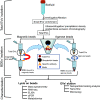Emergence of Extracellular Vesicles as "Liquid Biopsy" for Neurological Disorders: Boom or Bust
- PMID: 38351075
- PMCID: PMC10877757
- DOI: 10.1124/pharmrev.122.000788
Emergence of Extracellular Vesicles as "Liquid Biopsy" for Neurological Disorders: Boom or Bust
Abstract
Extracellular vesicles (EVs) have emerged as an attractive liquid biopsy approach in the diagnosis and prognosis of multiple diseases and disorders. The feasibility of enriching specific subpopulations of EVs from biofluids based on their unique surface markers has opened novel opportunities to gain molecular insight from various tissues and organs, including the brain. Over the past decade, EVs in bodily fluids have been extensively studied for biomarkers associated with various neurological disorders, such as Alzheimer's disease, Parkinson's disease, schizophrenia, bipolar disorder, major depressive disorders, substance use disorders, human immunodeficiency virus-associated neurocognitive disorder, and cancer/treatment-induced neurodegeneration. These studies have focused on the isolation and cargo characterization of either total EVs or brain cells, such as neuron-, astrocyte-, microglia-, oligodendrocyte-, pericyte-, and endothelial-derived EVs from biofluids to achieve early diagnosis and molecular characterization and to predict the treatment and intervention outcomes. The findings of these studies have demonstrated that EVs could serve as a repetitive and less invasive source of valuable molecular information for these neurological disorders, supplementing existing costly neuroimaging techniques and relatively invasive measures, like lumbar puncture. However, the initial excitement surrounding blood-based biomarkers for brain-related diseases has been tempered by challenges, such as lack of central nervous system specificity in EV markers, lengthy protocols, and the absence of standardized procedures for biological sample collection, EV isolation, and characterization. Nevertheless, with rapid advancements in the EV field, supported by improved isolation methods and sensitive assays for cargo characterization, brain cell-derived EVs continue to offer unparallel opportunities with significant translational implications for various neurological disorders. SIGNIFICANCE STATEMENT: Extracellular vesicles present a less invasive liquid biopsy approach in the diagnosis and prognosis of various neurological disorders. Characterizing these vesicles in biofluids holds the potential to yield valuable molecular information, thereby significantly impacting the development of novel biomarkers for various neurological disorders. This paper has reviewed the methodology employed to isolate extracellular vesicles derived from various brain cells in biofluids, their utility in enhancing the molecular understanding of neurodegeneration, and the potential challenges in this research field.
Copyright © 2024 by The Author(s).
Figures



Similar articles
-
Plasma neuronal exosomes serve as biomarkers of cognitive impairment in HIV infection and Alzheimer's disease.J Neurovirol. 2019 Oct;25(5):702-709. doi: 10.1007/s13365-018-0695-4. Epub 2019 Jan 4. J Neurovirol. 2019. PMID: 30610738 Free PMC article. Review.
-
Assessment of technical and clinical utility of a bead-based flow cytometry platform for multiparametric phenotyping of CNS-derived extracellular vesicles.Cell Commun Signal. 2023 Oct 6;21(1):276. doi: 10.1186/s12964-023-01308-9. Cell Commun Signal. 2023. PMID: 37803478 Free PMC article.
-
Extracellular vesicles in the study of Alzheimer's and Parkinson's diseases: Methodologies applied from cells to biofluids.J Neurochem. 2022 Nov;163(4):266-309. doi: 10.1111/jnc.15697. Epub 2022 Oct 22. J Neurochem. 2022. PMID: 36156258 Free PMC article. Review.
-
A new diagnostic tool for brain disorders: extracellular vesicles derived from neuron, astrocyte, and oligodendrocyte.Front Mol Neurosci. 2023 Aug 9;16:1194210. doi: 10.3389/fnmol.2023.1194210. eCollection 2023. Front Mol Neurosci. 2023. PMID: 37621405 Free PMC article. Review.
-
An optimized method for enrichment of whole brain-derived extracellular vesicles reveals insight into neurodegenerative processes in a mouse model of Alzheimer's disease.J Neurosci Methods. 2018 Sep 1;307:210-220. doi: 10.1016/j.jneumeth.2018.05.022. Epub 2018 Jun 9. J Neurosci Methods. 2018. PMID: 29894726 Free PMC article.
Cited by
-
Snorkel-tag based affinity chromatography for recombinant extracellular vesicle purification.J Extracell Vesicles. 2024 Oct;13(10):e12523. doi: 10.1002/jev2.12523. J Extracell Vesicles. 2024. PMID: 39400515 Free PMC article.
-
Prospects and challenges in using neuronal extracellular vesicles in biomarker research.Alzheimers Dement. 2024 Sep;20(9):6632-6638. doi: 10.1002/alz.13918. Epub 2024 Jul 15. Alzheimers Dement. 2024. PMID: 39009473 Free PMC article.
-
Emerging Role of Extracellular Vesicles as Biomarkers in Neurodegenerative Diseases and Their Clinical and Therapeutic Potential in Central Nervous System Pathologies.Int J Mol Sci. 2024 Sep 19;25(18):10068. doi: 10.3390/ijms251810068. Int J Mol Sci. 2024. PMID: 39337560 Free PMC article. Review.
-
Potential of sonobiopsy as a novel diagnosis tool for brain cancer.Mol Ther Oncol. 2024 Jun 24;32(3):200840. doi: 10.1016/j.omton.2024.200840. eCollection 2024 Sep 19. Mol Ther Oncol. 2024. PMID: 39077551 Free PMC article. Review.
-
Unveiling brain disorders using liquid biopsy and Raman spectroscopy.Nanoscale. 2024 Jun 27;16(25):11879-11913. doi: 10.1039/d4nr01413h. Nanoscale. 2024. PMID: 38845582 Review.
References
-
- Aaronson NK, Taphoorn MJ, Heimans JJ, Postma TJ, Gundy CM, Beute GN, Slotman BJ, Klein M (2011) Compromised health-related quality of life in patients with low-grade glioma. J Clin Oncol 29:4430–4435. - PubMed
-
- Agliardi C, Guerini FR, Zanzottera M, Bianchi A, Nemni R, Clerici M (2019) SNAP-25 in Serum Is Carried by Exosomes of Neuronal Origin and Is a Potential Biomarker of Alzheimer’s Disease. Mol Neurobiol 56:5792–5798. - PubMed
-
- Agliardi C, Meloni M, Guerini FR, Zanzottera M, Bolognesi E, Baglio F, Clerici M (2021) Oligomeric α-Syn and SNARE complex proteins in peripheral extracellular vesicles of neural origin are biomarkers for Parkinson’s disease. Neurobiol Dis 148:105185. - PubMed
Publication types
MeSH terms
Substances
Grants and funding
LinkOut - more resources
Full Text Sources
Medical
Miscellaneous
